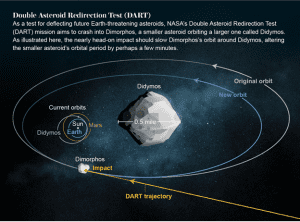TAG: GS 3: SCIENCE AND TECHNOLOGY
THE CONTEXT: In a recent study published in the journal The Planetary Science, scientists meticulously analyzed the aftermath of the Double Asteroid Redirection Test (DART) collision with Dimorphos.
EXPLANATION:
- Contrary to pre-impact predictions, the collision led to unexpected changes in both the shape and orbit of Dimorphos.
- Originally, Dimorphos was oblate, meaning it was rounded and slightly flattened at the poles.
- However, after the impact, it took on a prolate shape, becoming more elongated along one axis.
- This alteration in shape was not anticipated by the scientists prior to the mission.
Orbital Changes and Gravitational Disruption
- Beyond the shape transformation, the DART collision also significantly affected Dimorphos’s orbit around Didymos.
- The impact created a debris cloud, which disrupted the gravitational relationship between Dimorphos and its parent asteroid, Didymos.
- This disruption led to Dimorphos ending up in a shorter orbit than it had previously been in.
- The debris from the collision, acting as a form of thruster, reduced the moon’s orbital period, demonstrating that even relatively small impacts can have substantial gravitational consequences.
Potential Future Behavior of Dimorphos
- The study also speculated on the future behavior of Dimorphos following the collision.
- Scientists suggest that the moon may begin to tumble chaotically around its orbit due to the altered gravitational forces at play.
- While the exact timeline for this chaotic tumbling is uncertain, it raises important considerations for the stability and long-term dynamics of celestial bodies impacted by kinetic methods.
Implications for Future Missions
- The findings from the DART mission are especially relevant for NASA’s upcoming Hera mission, scheduled to reach the Didymos system in 2026.
- Hera will assess the properties of both Didymos and Dimorphos, building upon the data collected from the DART experiment.
- Understanding the changes in Dimorphos’s shape and orbit will be crucial for planning future planetary defense strategies, as it provides real-world evidence of how kinetic impacts can alter celestial objects.
Double Asteroid Redirection Test (DART) Mission
- It is a planetary defence-driven test of technologies for preventing an impact on Earth by a hazardous asteroid.
- The groundbreaking experiment that took place in 2022, targeting the near-Earth asteroid Didymos and its moon, Dimorphos.
- DART is the first technology demonstration of the kinetic impactor technique that could be used to mitigate the threat of an asteroid hitting Earth.
- The kinetic impactor mitigation technique is the impulsive deflection of the asteroid through the sudden addition of momentum.
- In simpler terms, DART is being sent to collide with an asteroid to change its orbital period.
- While Dimorphos itself did not pose any danger to our planet, the experiment provided valuable insights into how similar threats could be managed in the future.





